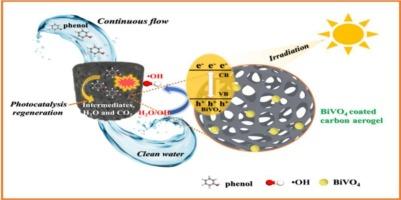具有独特光催化再生性能的 BiVO4 锚定碳气凝胶吸附剂可用于有效的水处理
IF 6.3
2区 工程技术
Q1 ENGINEERING, CHEMICAL
引用次数: 0
摘要
开发具有高吸附性能和易再生特性的吸附剂用于水处理是非常理想的,但仍然具有挑战性。本研究在碳气凝胶中负载了 BiVO4 光催化剂,从而构建了一种用于水净化的具有独特光催化再生性能的三维复合吸附剂(CA/BVO)。研究人员改变了 BiVO4 的负载量,以考察其对 CA/BVO 的吸附和光催化再生性能的影响。结果表明,最佳的 CA/BVO-2(适量的 BiVO4 加载量)能在长期连续的固定床吸附中实现有效的苯酚去除率(98.7%),并在四个吸附-再生循环后保持初始吸附性能的 80% 以上,其再生性能是单独使用 CA 的 20 倍。事实证明,-OH 在光催化再生过程中至关重要。此外,在实际地表水处理过程中,CA/BVO-2 表现出卓越的苯酚吸附能力和良好的重现性,其吸附能力甚至比超纯水背景下的吸附能力高出 14%。CA/BVO-2 在地表水中的吸附性能之所以得到增强,是因为腐殖酸和富勒酸成分中含有丰富的含氧基团,它们吸附在 CA/BVO-2 上,为苯酚的化学吸附提供了额外的有利位点。本文章由计算机程序翻译,如有差异,请以英文原文为准。

BiVO4-anchored carbon aerogel adsorbent with unique photocatalytic regeneration performance for effective water treatment
Developing adsorbent with both high adsorption performance and facile regeneration character for water treatment is highly desirable but remains challenging. In this work, the carbon aerogel was loaded with BiVO4 photocatalyst to construct a 3D composite adsorbent (CA/BVO) with distinctive photocatalytic regeneration performance for water purification, for which the CA/BVO after reaching adsorption saturation can be efficiently regenerated under visible-light illumination. The BiVO4 loading amount was varied to investigate its effect on adsorption and photocatalytic regeneration performance of CA/BVO. Results showed the optimal CA/BVO-2 (moderate BiVO4 loading) can realize effective phenol removal (98.7%) in long-term continuous fixed-bed adsorption and maintained over 80% of initial adsorption performance after four adsorption-regeneration cycles, whose regeneration performance was 20 times higher than that of CA alone. •OH was proven to be critical in photocatalytic regeneration process. Moreover, the CA/BVO-2 displayed superior phenol adsorption and good reproducibility during real surface water treatment, whose adsorption capacity was even 14% higher than that in ultrapure water background. The enhanced adsorption behavior of CA/BVO-2 in surface water was ascribed to the effect of coexisting components of humic acid and fulvic acid with rich oxygen-containing groups, which adsorbed on CA/BVO-2 and provided additional sites for favorable chemisorption of phenol.
求助全文
通过发布文献求助,成功后即可免费获取论文全文。
去求助
来源期刊

Journal of water process engineering
Biochemistry, Genetics and Molecular Biology-Biotechnology
CiteScore
10.70
自引率
8.60%
发文量
846
审稿时长
24 days
期刊介绍:
The Journal of Water Process Engineering aims to publish refereed, high-quality research papers with significant novelty and impact in all areas of the engineering of water and wastewater processing . Papers on advanced and novel treatment processes and technologies are particularly welcome. The Journal considers papers in areas such as nanotechnology and biotechnology applications in water, novel oxidation and separation processes, membrane processes (except those for desalination) , catalytic processes for the removal of water contaminants, sustainable processes, water reuse and recycling, water use and wastewater minimization, integrated/hybrid technology, process modeling of water treatment and novel treatment processes. Submissions on the subject of adsorbents, including standard measurements of adsorption kinetics and equilibrium will only be considered if there is a genuine case for novelty and contribution, for example highly novel, sustainable adsorbents and their use: papers on activated carbon-type materials derived from natural matter, or surfactant-modified clays and related minerals, would not fulfil this criterion. The Journal particularly welcomes contributions involving environmentally, economically and socially sustainable technology for water treatment, including those which are energy-efficient, with minimal or no chemical consumption, and capable of water recycling and reuse that minimizes the direct disposal of wastewater to the aquatic environment. Papers that describe novel ideas for solving issues related to water quality and availability are also welcome, as are those that show the transfer of techniques from other disciplines. The Journal will consider papers dealing with processes for various water matrices including drinking water (except desalination), domestic, urban and industrial wastewaters, in addition to their residues. It is expected that the journal will be of particular relevance to chemical and process engineers working in the field. The Journal welcomes Full Text papers, Short Communications, State-of-the-Art Reviews and Letters to Editors and Case Studies
 求助内容:
求助内容: 应助结果提醒方式:
应助结果提醒方式:


